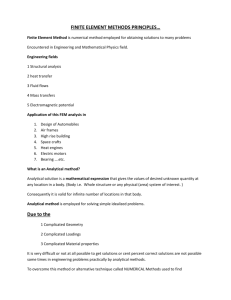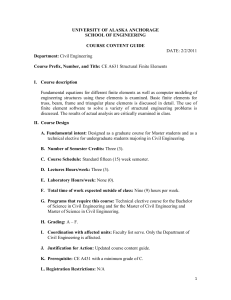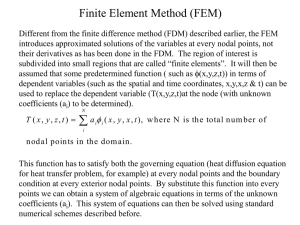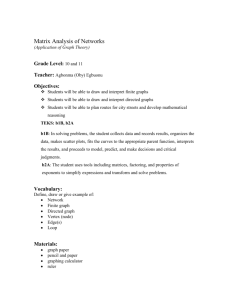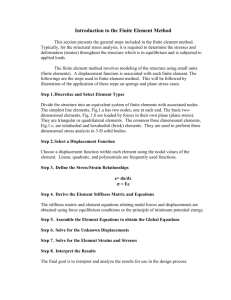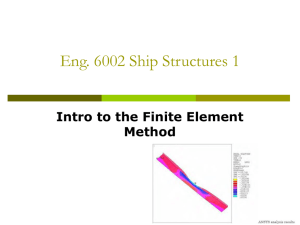Finite Element Method (FEM) Introduction
advertisement
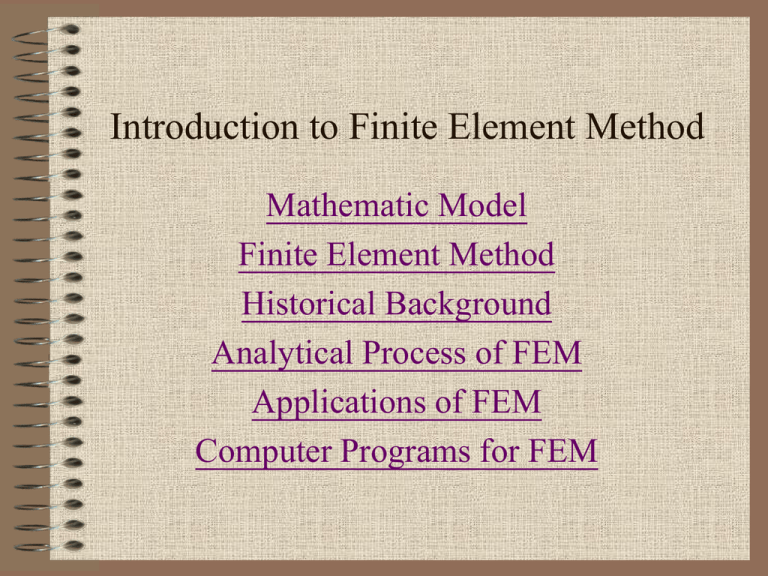
Introduction to Finite Element Method Mathematic Model Finite Element Method Historical Background Analytical Process of FEM Applications of FEM Computer Programs for FEM 1. Mathematical Model (1) Modeling Physical Problems Mathematica l Model Solution Identify control variables Assumptions (empirical law) (2) Types of solution Sol. Eq. Exact Sol. Approx. Sol. Exact Eq. Approx. Eq. ◎ ◎ ◎ ◎ (3) Methods of Solution (3) Method of Solution A. Classical methods They offer a high degree of insight, but the problems are difficult or impossible to solve for anything but simple geometries and loadings. B. Numerical methods (I) Energy: Minimize an expression for the potential energy of the structure over the whole domain. (II) Boundary element: Approximates functions satisfying the governing differential equations not the boundary conditions. (III) Finite difference: Replaces governing differential equations and boundary conditions with algebraic finite difference equations. (IV) Finite element: Approximates the behavior of an irregular, continuous structure under general loadings and constraints with an assembly of discrete elements. 2. Finite Element Method (1) Definition FEM is a numerical method for solving a system of governing equations over the domain of a continuous physical system, which is discretized into simple geometric shapes called finite element. Continuous system Time-independent PDE Time-dependent PDE Discrete system Linear algebraic eq. ODE (2) Discretization Modeling a body by dividing it into an equivalent system of finite elements interconnected at a finite number of points on each element called nodes. 3. Historical Background Chronicle of Finite Element Method Year Scholar Theory 1941 Hrennikoff Presented a solution of elasticity problem using one-dimensional elements. 1943 McHenry Same as above. 1943 Courant 1947 Levy Introduced shape functions over triangular subregions to model the whole region. Developed the force (flexibility) method for structure problem. 1953 Levy Developed the displacement (stiffness) method for structure problem. 1954 Argyris & Kelsey Developed matrix structural analysis methods using energy principles. 1956 Turner, Clough, Martin, Topp Derived stiffness matrices for truss, beam and 2D plane stress elements. Direct stiffness method. 1960 Clough Introduced the phrase finite element . 1960 Turner et. al Large deflection and thermal analysis. 1961 Melosh Developed plate bending element stiffness matrix. 1961 Martin Developed the tetrahedral stiffness matrix for 3D problems. 1962 Gallagher et al Material nonlinearity. Chronicle of Finite Element Method Year Scholar Theory 1963 Grafton, Strome Developed curved-shell bending element stiffness matrix. 1963 Melosh Applied variational formulation to solve nonstructural problems. 1965 Clough et. al 3D elements of axisymmetric solids. 1967 Zienkiewicz et. Published the first book on finite element. 1968 Zienkiewicz et. Visco-elasticity problems. 1969 Szabo & Lee Adapted weighted residual methods in structural analysis. 1972 Oden Book on nonlinear continua. 1976 Belytschko Large-displacement nonlinear dynamic behavior. ~1997 New element development, convergence studies, the developments of supercomputers, the availability of powerful microcomputers, the development of user-friendly general-purpose finite element software packages. 4. Analytical Processes of Finite Element Method (1) Structural stress analysis problem A. Conditions that solution must satisfy a. Equilibrium b. Compatibility c. Constitutive law d. Boundary conditions Above conditions are used to generate a system of equations representing system behavior. B. Approach a. Force (flexibility) method: internal forces as unknowns. b. Displacement (stiffness) method: nodal disp. As unknowns. For computational purpose, the displacement method is more desirable because its formulation is simple. A vast majority of general purpose FE softwares have incorporated the displacement method for solving structural problems. (2) Analysis procedures of linear static structural analysis A. Build up geometric model a. 1D problem line b. 2D problem surface c. 3D problem solid B. Construct the finite element model a. Discretize and select the element types (a) element type 1D line element 2D element 3D brick element (b) total number of element (mesh) 1D: 2D: 3D: b. Select a shape function 1D line element: u=ax+b c. Define the compatibility and constitutive law d. Form the element stiffness matrix and equations (a) Direct equilibrium method (b) Work or energy method (c) Method of weight Residuals e. Form the system equation Assemble the element equations to obtain global system equation and introduce boundary conditions C. Solve the system equations a. elimination method Gauss’s method (Nastran) b. iteration method Gauss Seidel’s method Displacement field strain field stress field D. Interpret the results (postprocessing) a. deformation plot b. stress contour 5. Applications of Finite Element Method Structural Problem Non-structural Problem Stress Analysis - truss & frame analysis - stress concentrated problem Buckling problem Vibration Analysis Impact Problem Heat Transfer Fluid Mechanics Electric or Magnetic Potential 6. Computer Programs for Finite Element Method 結構 非線 性 最佳 化 複合 材料 ANSYS ◎ D ◎ ◎ NASTRAN ◎ D ◎ ◎ ABAQUS ◎ ◎ MARC ◎ ◎ 碰撞 分析 噪音 分析 流力 分析 D ◎ ◎ D ◎ ◎ ◎ ◎ ◎ ◎ ◎ ◎ LS-DYNA3D ◎ MSC/DYNA ◎ 疲勞 分析 模流 分析 ◎ ◎ D ◎ ◎ D ◎ ◎ MOLDFLOW ◎ C-FLOW ◎ PHOENICS 熱傳 分析 ◎ ADAMS/ DADS COSMOS 機構 分析 ◎ ◎



